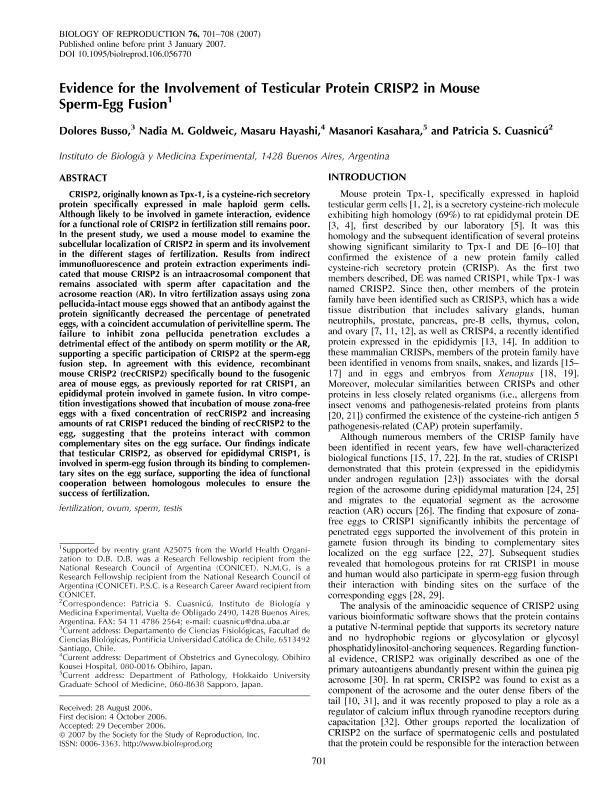Artículo
Evidence for the involvement of testicular protein CRISP2 in mouse sperm-egg fusion
Busso, Dolores; Goldweic, Nadia Micaela ; Hayashi, Masaru; Kasahara, Masanori; Cuasnicu, Patricia Sara
; Hayashi, Masaru; Kasahara, Masanori; Cuasnicu, Patricia Sara
 ; Hayashi, Masaru; Kasahara, Masanori; Cuasnicu, Patricia Sara
; Hayashi, Masaru; Kasahara, Masanori; Cuasnicu, Patricia Sara
Fecha de publicación:
04/2007
Editorial:
Society for the Study of Reproduction
Revista:
Biology of Reproduction
ISSN:
0006-3363
e-ISSN:
1529-7268
Idioma:
Inglés
Tipo de recurso:
Artículo publicado
Clasificación temática:
Resumen
CRISP2, originally known as Tpx-1, is a cysteine-rich secretory protein specifically expressed in male haploid germ cells. Although likely to be involved in gamete interaction, evidence for a functional role of CRISP2 in fertilization still remains poor. In the present study, we used a mouse model to examine the subcellular localization of CRISP2 in sperm and its involvement in the different stages of fertilization. Results from indirect immunofluorescence and protein extraction experiments indicated that mouse CRISP2 is an intraacrosomal component that remains associated with sperm after capacitation and the acrosome reaction (AR). In vitro fertilization assays using zona pellucida-intact mouse eggs showed that an antibody against the protein significantly decreased the percentage of penetrated eggs, with a coincident accumulation of perivitelline sperm. The failure to inhibit zona pellucida penetration excludes a detrimental effect of the antibody on sperm motility or the AR, supporting a specific participation of CRISP2 at the sperm-egg fusion step. In agreement with this evidence, recombinant mouse CRISP2 (recCRISP2) specifically bound to the fusogenic area of mouse eggs, as previously reported for rat CRISP1, an epididymal protein involved in gamete fusion. In vitro competition investigations showed that incubation of mouse zona-free eggs with a fixed concentration of recCRISP2 and increasing amounts of rat CRISP1 reduced the binding of recCRISP2 to the egg, suggesting that the proteins interact with common complementary sites on the egg surface. Our findings indicate that testicular CRISP2, as observed for epididymal CRISP1, is involved in sperm-egg fusion through its binding to complementary sites on the egg surface, supporting the idea of functional cooperation between homologous molecules to ensure the success of fertilization.
Palabras clave:
Fertilization
,
Ovum
,
Sperm
,
Testis
Archivos asociados
Licencia
Identificadores
Colecciones
Articulos(IBYME)
Articulos de INST.DE BIOLOGIA Y MEDICINA EXPERIMENTAL (I)
Articulos de INST.DE BIOLOGIA Y MEDICINA EXPERIMENTAL (I)
Citación
Busso, Dolores; Goldweic, Nadia Micaela; Hayashi, Masaru; Kasahara, Masanori; Cuasnicu, Patricia Sara; Evidence for the involvement of testicular protein CRISP2 in mouse sperm-egg fusion; Society for the Study of Reproduction; Biology of Reproduction; 76; 4; 4-2007; 701-708
Compartir
Altmétricas



